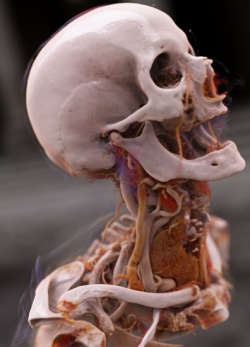Siemens Computed Tomography
40 Years at the cutting edge of technological development
40 years after the launch of its first series model, Siretom, Siemens Healthcare is looking back on the successful development of its computed tomography division. With innovations such as Spiral, Multislice, and most recently Dual Source technology, Siemens has been driving the CT market and clinical diagnostics for decades. Today, three patients are scanned with a Siemens CT system every second. The company's portfolio ranges from robust systems for basic care, such as Somatom Scope, through to the world's fastest and most powerful CT scanner, Somatom Force.

Its peak values show how rapidly technology has progressed for physicians and patients: While Siretom took around nine minutes to perform a complete head scan back in 1975, today Somatom Force can scan the entire upper body in under one second with an X-ray dose of less than 0.1 millisievert – around the same amount of radiation exposure as an intercontinental flight.
"Together with our clinical research partners and customers, we have made things possible in the last 40 years that others didn't even dare to try," says Walter Märzendorfer, CEO of Computed Tomography and Radiation Oncology at Siemens Healthcare, "such as Dual Source technology." Since presenting the world's first Dual Source CT, Somatom Definition, back in 2005, Siemens has fitted all its top devices with two X-ray tubes and detectors. This technology allowed Somatom Definition to produce clinical images at a previously unheard-of speed. The beating heart can now be scanned in fractions of a second, and heart CT imaging has become a routine clinical procedure. Dual Source CT also paved the way for spectral dual energy imaging, which can precisely differentiate between the different materials in the body – tissue, bones, and implants. Somatom Force is also based on the successful dual source principle.
Other Siemens technologies are now also common throughout the CT market, such as the Spiral scan, which Siemens brought to the market in 1990. Here, the detector continually rotates around the table, which moves steadily through the gantry. The measurement system therefore moves on a spiral track around the patient. This meant that Somatom Plus-S, which could precisely map entire regions of the body in one pass, was the first volume spiral scanner on the market. In 1998, the multislice technology in Somatom Volume Zoom made non-invasive vascular imaging possible in routine procedures for the first time. This played a key role in the breakthrough of heart CT.
Toward the future of CT with Somatom Force
"In the coming decades, we will continue to work on setting new standards and making our technologies available to more and more people," promises Märzendorfer. The current, high-end Somatom Force system is already pointing to the future of computed tomography. It enables particularly gentle examinations since up to less than half the X-ray and contrast medium dose is required compared with existing premium systems. At up to 74 cm per second, the scan speed of Somatom Force is so high that patients no longer have to hold their breath or stay still. This means that Siemens Healthcare has overcome significant challenges in CT, opening up access to state-of-the-art medical imaging to even the most sensitive patient groups such as small children or people with renal failure. "This CT enables earlier and more precise disease diagnosis. It is the ideal basis on which to make individual therapy decisions for each patient," emphasizes Märzendorfer.
A year after its market launch, the computer tomograph developed and produced at the division's headquarters in Forchheim, Upper Franconia, Germany, is already used in a number of leading university hospitals across the globe. This has allowed Siemens Healthcare to strengthen its position as market leader in the high-end CT sector. The system is safeguarded by more than 90 new patents, including the Vectron X-ray tubes, which have helped reduce the contrast medium for thorax examinations from 90–110 milliliter to 25–35 milliliter. Siemens CT therefore uses over 50% less than other premium systems, making it a viable option for older people and patients with renal failure such as diabetics, for whom contrast medium exerts too much of a strain.
Technology that benefits the patient
Patients stand to benefit from the fact that 4D imaging on Somatom Force requires less than half the X-ray dose than was previously needed to characterize tumors and to detect whether a cancer treatment is effective at an early stage. This procedure can now be routinely implemented, and physicians can make faster and better-founded decisions about the best tumor therapy for an individual. Technical innovations play a key role here, too: The highly sensitive Stellar Infinity detector and Adaptive Dose Shield for blocking unnecessary radiation.
With the help of the Turbo Flash Scan and two spectral filters for optimizing the X-ray spectrum, the X-ray dose can also be significantly reduced: Clinical studies have shown that scanning the rib cage for lung nodules using Somatom Force CT can be performed with the very low effective dose of 0.06 millisievert. This radiation dose for a CT scan is no higher than that for a conventional X-ray thorax examination. This means that it could potentially be used for early detection examinations, for example in cases of suspected lung cancer or heart disease.
The scan speed of Somatom Force has also significantly advanced innovation: Thanks to the fastest acquisition speed on the CT market (74 cm per second), thorax examinations can now be performed in under a second. Cardiac patients therefore no longer have to take beta-blockers to slow their pulse to prevent motion artifacts. This speed also pays off when examining patients who are unable to hold their breath for several seconds – critically ill patients, trauma cases, or babies, for example. With Somatom Force, breath-holding is no longer necessary in almost all radiology cases.
Source: Siemens AG
29.07.2015











